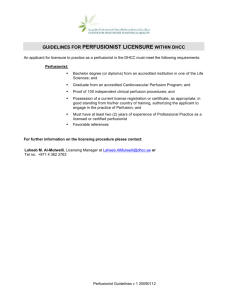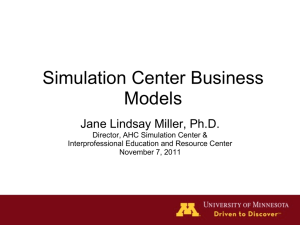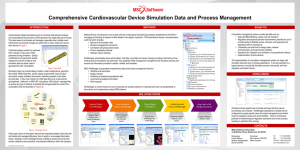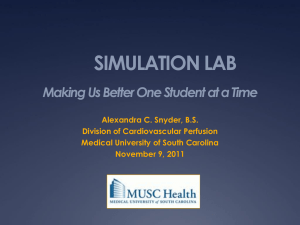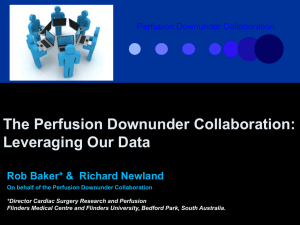A_Simulation (Maggie)
advertisement
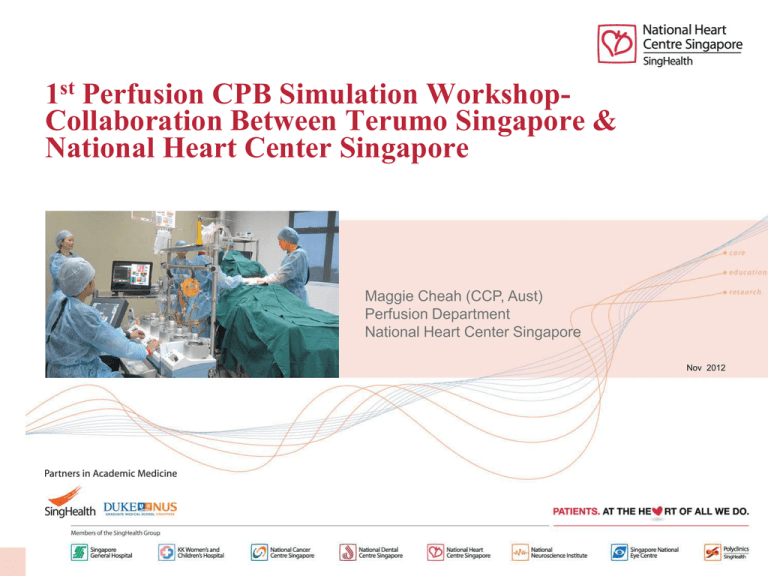
1st Perfusion CPB Simulation WorkshopCollaboration Between Terumo Singapore & National Heart Center Singapore Maggie Cheah (CCP, Aust) Perfusion Department National Heart Center Singapore Nov 2012 Introduction • Perfusionist training has been in the form of on-the-job training, hands-on-practical sessions • Simulation is a technique – to replace or amplify real experiences with guided experiences that evoke or replicate substantial aspects of the real world in a fully interactive manner Gaba DM. The Future Vision of Simulation in Healthcare. Quality and Safety in Heathcare. 2004; Oct 13th Suppl: 2-10. • Simulation has been used in the initial and ongoing training and professional development of many different professions • In the US, simulation has been integrated into the clinical course and training curriculum of perfusionist 2 Simulation in Process….. 3 Simulation in Perfusion • Initial skills development – individual skills & standard techniques • Development and refinement of skills – advanced techniques • Crisis/emergency management 4 Simulation in Perfusion Initial skills development – individual skills & standard techniques like: Initiation & Weaning of CPB Cardioplegia delivery Blood gas monitoring and interpretation Hemodynamic monitoring Communication with other surgical team 5 Simulation in Perfusion Development and refinement of skills – advanced techniques: VAVD IABP Circulatory arrest, retrograde cerebral perfusion Retrograde autologous priming Aortic insufficiency Aortic dissection 6 Simulation in Perfusion Crisis/emergency management Oxygenator failure Electrical/mechanical failure Gross air embolism Drug/transfusion reaction Line separation Loss of venous return Circuit coagulation 7 Simulation in Perfusion Aim: 1. Competitive understanding of the duties of a perfusionist 2. Competent with the major skills of a perfusionist 3. Practice good technique 4. Fully explore and understand the ramifications of bad techniques 8 Simulation Process Start Do Teach/ feedback Do No Assessment acceptable Yes End 9 Assessment Evaluation system (1,2,3,4) Evaluation System Guideline from AMSECT 10 Simulators • Bucket/ Bag • Abiomed • Mid- western University Simulation Model • Orpheus Perfusion Simulator • ECC-SIM Mid- western Model 11 Orpheus Perfusion Simulator 12 Simulation Platforms 13 ECCSIM • Extra Corporeal Circulation SIMulator • Virtual patient model- reproduce the hemodynamic & metabolism state of a patient 14 ECCSIM • Composed of a numerical section (virtual patient model) – computer that stimulate vital patient behaviors • Plus a hydraulic section – simple hydraulic mock circulation loop Web Master Shinji Ninomiya Department of Clinical Engineering, Faculty of Health Sciences Hiroshima International University 15 ECCSIM 16 ECCSIM 17 ECCSIM • The instructor can control several events • Conduct trouble events such as kink of the arterial line or venous line Visual interface for instructor 18 ECCSIM 19 ECCSIM 20 1st Basic- Intermediate Perfusion Stimulation • 1st basic-intermediate perfusion simulation workshop in South East Asia at 31/03/2012 • at Innoheart, Singapore (a pre-clinical contract research organisation) • organised by the National Heart Center Singapore (NHCS) Perfusion Unit, sponsored by Terumo, Singapore and supported by the Singapore Society of Extracorporeal Technology. Singapore Society of Extracorporeal Circulation Technology 21 Basic- Intermediate Perfusion Workshop Terumo System 1 HLM Terumo RX25 Oxygenator • No Heatercooler • Circuit preprimed and debubbled Trainer Station 22 Patient & Perfusionist Monitor Program outline • Lectures and introduction. • Topics coverage: Principles and basics of CPB Adequacy of perfusion Myocardial preservation in CPB Simulation in perfusion 23 Simulation Sessions • 6 participants from 3 Hospitals- NHCS, National University Hospital & Mount Elizabeth Hospital • 2 participants in each group take turn to carry out the simulation training • Each simulation session 40-45 mins 24 Role play • 2 instructors – Surgeon & Assistant surgeon • 1 simulator controller – Anaesthetist • 4 evaluators/ observers • 2 participants – primary perfusionist & assistant perfusionist 25 Simulation Training • Repetition of scenarios were conducted •10- 15 mins of debriefing by the evaluators after each scenario Active participation & interaction 26 Group discussion • Entire simulation session was video recorded • The participants were given consent release form & evaluation form • Exchange perfusion knowledge within perfusionist • ECCSIM- Event trend log Participants will aware of the trend of CPB pressure during the event 27 Benefits of the Workshop By repetitive practice & feedback in a realistic but safe environment, the simulation workshop serves to: 1. Consolidate particular skills, e.g. procedural skills- initiation of bypass, coming off bypass, cardiopledia delevery etc. 2. Develop skills in patient/ system monitoring 3. Communication with other surgical team members in a concise & professional manner 4. Increase situation awareness 5. Consolidate other skills like crisis management – poor venous return/ air lock, aortic dissection etc. 28 Conclusion • Simulation will serve as an invaluable tool in perfusion education. • Its role in perfusion training & advancement of techniques will certainly expand in the future 29 This presentation contains information which is confidential and/or legally privileged. No part of this presentation may be disseminated, distributed, copied, reproduced or relied upon without the expressed authorisation of SingHealth. http://www.singhealthacademy.edu.sg/Pages/asca2013.aspx
